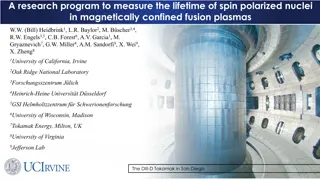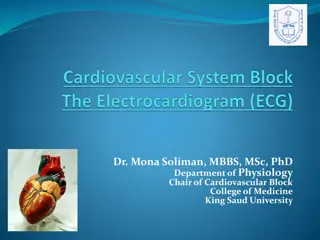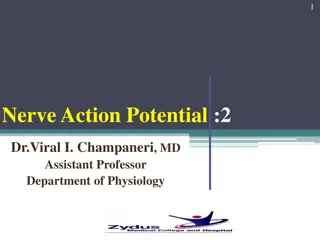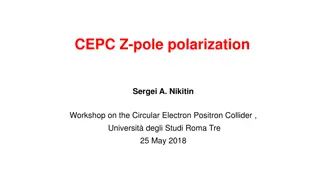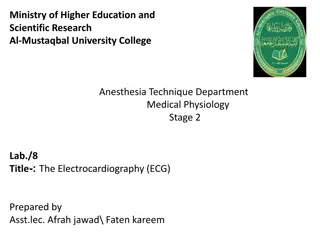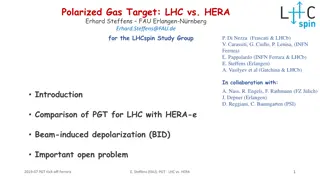Research Program on Spin Polarized Nuclei in Fusion Plasmas
Examination of spin polarized fuel in fusion plasmas to enhance energy production efficiency. Planned experiments aim to measure the lifetime of polarized nuclei for optimized fusion reactions. Key aspects include depolarization mechanisms, neutral beam heating, and fueling techniques with pellets.
1 views • 36 slides
Overview of Antiarrhythmic Drugs Use and Classification
Antiarrhythmic drugs are classified into different classes based on their mechanisms of action. Class I includes sodium channel blockers with specific drugs like procainamide, disopyramide, and quinidine. Class 1B involves lidocaine and mexiletine. Class 1C consists of agents like flecainide. Class
2 views • 19 slides
Understanding Local Anesthetic Systemic Toxicity in Anesthesia Practice
Local anesthetics are crucial in anesthesia for their ability to prevent nerve depolarization, but systemic toxicity can lead to serious complications. Last Causes, signs, and max dosage discussion along with the importance of recognizing early signs like lightheadedness, tinnitus, and late symptoms
0 views • 19 slides
Understanding the Normal Electrocardiogram (ECG) in Cardiovascular Physiology
Dr. Mona Soliman, MBBS, MSc, PhD from King Saud University explains the waves, intervals, and leads of a normal ECG in detail. The ECG records the heart's electrical activity, showcasing depolarization and repolarization waves. Learn about P-wave (atrial depolarization), QRS complex (ventricular dep
1 views • 24 slides
Understanding Nerve Action Potentials: Key Stages and Mechanisms
Explore the intricate process of nerve action potentials, including depolarization, overshoot variations, repolarization stages, and the role of ion levels. Delve into the details of how neurons generate and propagate electrical signals essential for communication in the nervous system.
1 views • 63 slides
Understanding Local Anesthesia and Nerve Conduction Blockade
Local Anesthetics (LAs) are drugs that abolish sensations like pain in specific body areas by blocking nerve conduction of sensory impulses. This process involves reducing the influx of sodium ions, preventing membrane depolarization, and inhibiting action potential conduction. LAs are weak bases wi
0 views • 22 slides
Understanding Membrane Potential and Action Potentials in Excitable Cells
Membrane potential, resting potential, and action potentials play crucial roles in the functioning of excitable cells like neurons, muscle cells, and endocrine cells. Voltage-gated channels, depolarization, and repolarization are key processes involved in generating and propagating action potentials
0 views • 26 slides
Radiative Polarization Techniques in CEPC for Precision Measurements of Z-Pole Mass
Prof. Jie Gao led discussions on the CEPC polarization program, focusing on obtaining transverse and longitudinal polarizations. The use of special wigglers to enhance the polarizing effect of the magnetic field was highlighted, reducing the time needed for radiative self-polarization. Strategies to
0 views • 22 slides
Beam Polarization Simulation Study for CEPC
Simulation study on beam polarization for the Circular Electron Positron Collider (CEPC) using the PTC Poly- morphic Tracking Code. The study includes orbital and spin tracking, equilibrium polarization calculation, and Monte-Carlo simulation of depolarization rate. Comparison with other Monte-Carlo
0 views • 20 slides
Stratospheric Aerosol Subtyping Confidence and Lidar Ratio Uncertainty
This research delves into the classification confidence of stratospheric aerosol subtypes and possibilities for quantifying uncertainties in lidar ratio estimates due to inaccurate classification. It discusses CALIOP initial aerosol lidar ratios, optical properties of stratospheric aerosol layers, c
0 views • 15 slides
Understanding Skeletal Muscle Relaxants and Muscle Contraction Mechanisms
Skeletal muscle relaxants play a crucial role in relaxing muscles without affecting consciousness significantly. They are classified into neuromuscular blockers and spasmolytics, each targeting different mechanisms in the body. Muscle contraction occurs through the release of acetylcholine and the s
0 views • 27 slides
Understanding Electrocardiography (ECG) in Medical Physiology Stage 2 Lab
Electrocardiography (ECG) is a vital tool for recording the electrical activities of the heart muscle. This process involves detecting depolarization and repolarization through various waves such as P-wave, QRS complex, and T-wave. Understanding ECG components like PR segment, ST segment, and U-wave
0 views • 10 slides
Comparing Polarized Gas Targets at LHC and HERA for Spin Studies
The comparison between Polarized Gas Targets (PGT) at the Large Hadron Collider (LHC) and HERA for spin studies is discussed. Key considerations such as beam-induced depolarization, beam parameters, and design aspects are highlighted. The importance of using a polarized gas target similar to HERMES
0 views • 15 slides
